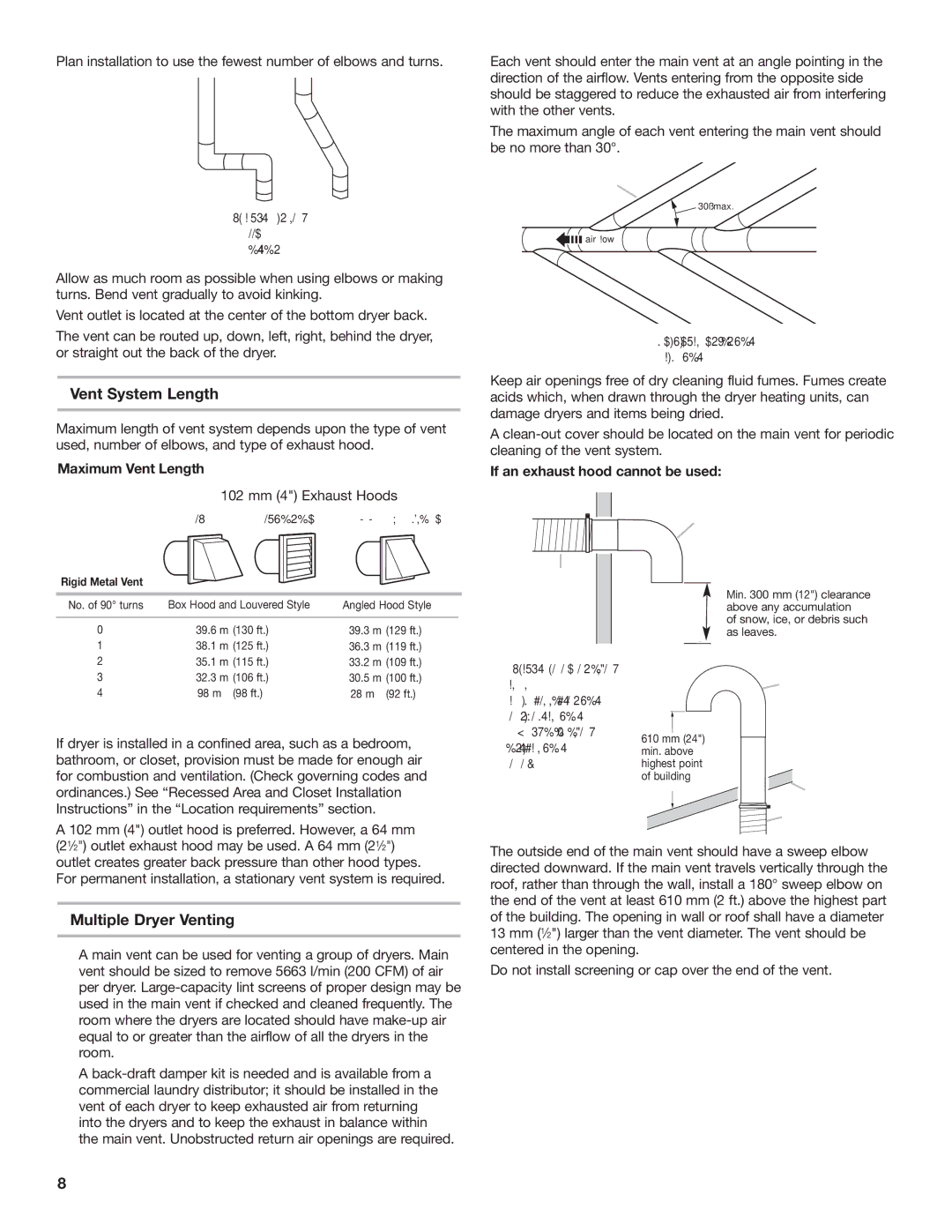Commercial HE Dryer Installation Instructions
W10239207B
Table of Contents
Table DES Matieres
Índice
Indice
Dryer Safety
Your safety and the safety of others are very important
Dryer Disposal Installation Requirements
Tools and Parts
Location Requirements
Tools needed
Recessed Area and Closet Installation Instructions
Product Dimensions 686 mm 27 dryer
Minimum Installation Clearances
Electrical Requirements Gas Dryer
Using the universal cord included with this dryer
Gas Supply Requirements
Gas Supply
Important Observe all governing codes and ordinances
Venting Requirements
Natural Gas
Gas
Natural gas France/Belgium
Vent System Length
Multiple Dryer Venting
Maximum Vent Length
If an exhaust hood cannot be used
Installation Instructions GAS Dryer
Install Leveling Legs
Complete Installation
Make Gas Connection
Maintenance Instructions
Technical Specifications GAS Dryer
Maintenance instructions
If dryer does not operate, check the following
Remove the Door Assembly
Lift the inner door assembly off the outer door assembly
Reversing the Door Swing
Reverse Hinge
Reinstall the door
Reverse the strike
Electronic Control Setup
General User Information
SET-UP Codes
Control SET-UP Procedures
Display
Special Pricing Option
5 Special DRY Time
0 TIME-OF-DAY CLOCK, Minutes
0 TIME-OF-DAY CLOCK,HOURS
Exit from SET-UP Mode
Disclaimer of Implied Warranties Limitations of Remedies
Limited Warranty on Parts
Items Maytag will not PAY for
Securite DU SECHE-LINGE
Votre sécurité et celle des autres est très importante
Elimination DU SECHE-LINGE Exigences D’INSTALLATION
Outillage et pièces
Outillage nécessaire
Pièces fournies
Exigences d’emplacement
Dimensions du produit Sèche-linge de 686 mm
Encastrement, vue avant Placard, vue latérale
76 mm
De 0,054 Ohm + j0,034 Ohm
715 mm 281/8
Spécifications de l’alimentation en gaz
Exigences concernant l’évacuation
Longueur du circuit d’évacuation
Longueur maximale du conduit
Clapet de décharge de 102 mm
Si une bouche de décharge ne peut être utilisée
Installation des pieds de nivellement
Évacuation multiple du sèche-linge
Achever l’installation
Instructions D’ENTRETIEN
Raccordement à la canalisation de gaz
Raccordement du conduit d’évacuation
Fiche Technique SECHE-LINGE a GAZ
Si vous avez besoin d’assistance
Dépose de l’armature de la porte
Inversion de la charnière
Réinstallation de la porte
Inversion de la gâche
Procedures DE Reglage DU Controle
Informations Generalespour L’UTILISATEUR
Affichage
Codes DE Reglage
Option DE Compteur D’ARGENT
Option DE Tarif Special
5 Duree DE Sechage Special
0 Horloge Heure DU JOUR, Minutes
Quitter LE Mode DE Configuration
FIN DES Procedures DE Configuration
Option DE Boite DE Monnaiea Glissiere
Option Effacer LE Depot
Garantie Limitée SUR LES Pièces
Maytag NE Paiera PAS Pour
Seguridad DE LA Secadora
Para SU Seguridad
Eliminación DE LA Secadora Requisitos DE Instalación
Herramientas necesarias
Piezas suministradas
Si va a instalar una secadora a gas
Dimensionesdel productoSecadora de 686 mm
Requisitos eléctricos Secadora a gas
Instruccionesparala instalación empotrada o en armario
La secadora deberá ventilarse al exterior
Requisitos del suministro de gas
Cómo utilizar el cable universal provisto con esta secadora
Suministro de gas
Gas natural
Requisitos de la línea de suministro
Requisitos de ventilación
Gas L.P
Largo del sistema de ventilación
Ventilación para múltiples secadoras
Longitud máxima del conducto de escape
Si no puede usarse una capota de ventilación
Instalación de las patas niveladoras
Conexión del suministro de gas
Conexión del ducto de escape
Complete la instalación
Instrucciones DE Mantenimiento
Instrucciones de mantenimiento
Limpie el filtro de pelusa después de cada ciclo
Si la secadora no funciona, revise lo siguiente
Use un pequeño destornillador de hoja plana para quitar las
Cómo quitar el ensamblaje de la puerta
Invierta la bisagra
Vuelva a instalar la puerta
Cómo invertir el tope
Programación DEL Control Electrónico
Importante
Información Generalpara EL Usuario
Procedimientosde Programación DEL Control
Pantalla
Códigos DE Programación
Opción DE Contadorde Dinero
Opción DE Preciosespeciales
6 Precio Para Ciclosespeciales
Tiempo DE Secado Especial
Cómo Salir DEL Modo DE Programación
Opción DE Tragamonedas
Opción DE Suspensión DE Precios
0 Incremento DE Centésimos
Exclusión DE Garantías Implícitas Limitaciones DE Recursos
Garantía Limitada EN LAS Piezas
Maytag no Pagará POR LOS Siguientes Artículos
Sicurezza DELL’ASCIUGATRICE
La sicurezza dell’utente e degli altri è fondamentale
’ELIMINAZIONE DELL’ASCIUGATRICE Requisiti D’INSTALLAZIONE
Attrezzi e componenti
Requisiti di ubicazione
Attrezzi necessari
Istruzioni di installazione incassata e in armadi
Dimensionidel prodottoasciugatrice da 686 mm
Spazi minimi di installazione
Requisiti elettrici Asciugatrice a gas
Non utilizzare adattatori. Non utilizzare prolunghe
Requisiti di alimentazione del gas
Alimentazione del gas
Requisiti di scarico
Gas naturale
Gas di petrolio liquefatto
Requisiti del cavo di alimentazione
Lunghezza dell’impianto di scarico
Scarico di asciugatrici multiple
Lunghezza massima dello scarico
Se è impossibile utilizzare una cappa di scarico
Installazione dei piedini di regolazione
Eseguire il collegamento gas
Connessione dello scarico
Rimuovere il tappo rosso dal tubo del gas
Completamento dell’installazione
Istruzioni DI Manutenzione
Dati Tecnici Asciugatrice a GAS
Istruzioni di manutenzione
Se l’asciugatrice non funziona controllare che
Inversione della cerniera
Inversione Della Rotazione DI Apertura
Rimozione del gruppo dello sportello
Reinstallazione dello sportello
Inversione del battente
Procedure DI Configurazione DEI Comandi
Informazioni Generali PER L’UTENTE
Codici DI Configurazione
Prezzo Ciclo Regolare
Tempo Asciugatura Regolare
Tipi DI Prezzi DI Asciugatura
Opzione Conteggio Denaro
Opzione Prezzo Speciale
5 Tempo Asciugatura Speciale
0 Orario DEL GIORNO,MINUTI
Uscita Dalla Modalità DI Configurazione
Garanzia Limitata SUI Pezzi
Voci NON a Carico DI Maytag
Limitazione Delle Garanzie Implicite Limitazione DEI Rimedi
W10239207B

![]() B
B